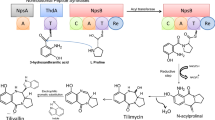Abstract
A 14-year-old boy who was neutropenic following chemotherapy for leukemia developed fungemia caused by the yeast Kodomaea ohmeri (Pichia ohmeri). The infection was cured by catheter removal and the use of fluconazole. A 74-year-old man who had undergone surgeries for a subcutaneous tumor developed polymicrobic cellulitis involving Kodomaea ohmeri. Despite surgical debridement and antibiotic therapy, the patient died of complications. Including these 2 cases, there have been 10 Kodomaea ohmeri infections reported thus far, all occurring in patients with pre-existing conditions. There have been seven cases of fungemia and one case each of peritonitis, funguria, and cellulitis. The treatment employed varied depending on the site/source of infection. Seven patients recovered and three died. The microbiological data available suggest that Kodomaea ohmeri can be identified definitively by biochemical tests and is susceptible to amphotericin B and either susceptible to or dose dependently susceptible to itraconazole and fluconazole.
Similar content being viewed by others
References
Yamada Y, Suzuki T, Matsuda M, Mikata K (1995) The phylogeny of Yamadazyma ohmeri (Etchells et Bell) Billon-Grand based on the partial sequences of 18S and 26S ribosomal RNAs: the proposal of Kodamaea gen. nov. (Saccharomycetaceae). Biosci Biotechnol Biochem 59:1172–1174
Kurtzman CP (1998) Pichia. In: Kurtzman CP, Fell JW (eds) The yeasts: a taxonomic study, 4th edn. Amsterdam, Elsevier, pp 273–352
Bergman MM, Gagnon D, Doern GV (1998) Pichia ohmeri fungemia. Diagn Microbiol Infect Dis 30:229–231
Matute AJ, Visser MR Lipovsky M, Schuitemaker FJ, Hoepelman AIM (2000) A case of disseminated infection with Pichia ohmeri. Eur J Clin Microbiol Infect Dis 19:971–973
Choy BY, Wong SS (2000) Pichia ohmeri peritonitis in a patient on CAPD: response to treatment with amphotericin. Perit Dial Int 20:91
Reina J.P, Larone DH (2002) Pichia ohmeri prosthetic valve endocarditis and review of the literature. Scand J Infect Dis 34:140–141
Puerto JL, Garcia-Martos P, Saldarreaga A, Ruiz-Aragon J, Garcia-Agudo R, Aoufi S (2002) First report of urinary tract infection due to Pichia ohmeri. Eur J Clin Microbiol Infect Dis 21:630–631
João I, Duarte J, Cotrim C, Rodrigues A, Martins C, Fazendas P, Oliveira LM, Diogo J, Carrageta M (2002) Native valve endocarditis due to Pichia ohmeri. Heart Vessels 16:260–263
Hitomi S, Kumao T, Onizawa K, Miyajima Y, Wakatsuki T (2002) A case of central-venous-catheter-associated infection caused by Pichia ohmeri. J Hosp Infect 51:75–77
Shin DH, Park JH, Shin JH, Suh SP, Ryang DW, Kim SJ (2003) Pichia ohmeri fungemia associated with phlebitis: successful treatment with amphotericin B. J Infect Chemother 9:88–89
National Committee for Clinical Laboratory Standards (2002) Reference methods for broth dilution antifungal susceptibility testing of yeasts. Approved standard M27-A2. NCCLS, Wayne, PA, p 22
Han XY, Pham AS, Tarrand JJ, Sood PK, Luthra R (2002) Rapid and accurate identification of mycobacteria by sequencing the hypervariable regions of the 16S ribosomal RNA gene. Am J Clin Pathol 118:796–801
ChenYC, Eisner JD, Kattar MM, Rassoulian-Barrett SL, LaFe K, Yarfitz SL, Limaye AP, Cookson BT (2000) Identification of medically important yeasts using PCR-based detection of DNA sequence polymorphisms in the internal transcribed spacer 2 region of the rRNA genes. J Clin Microbiol 38:2302–2310
Pfaller MA (1995) Epidemiology of candidiasis. J Hosp Infect 30 (Suppl):329–338
Abi-Said D, Anaissie E, Uzun O, Raad I, Pinzcowski H, Vartivarian S (1997) The epidemiology of hematogenous candidiasis caused by different Candida species. Clin Infect Dis 24:1122–1128
Viscoli C, Girmenia C, Marinus A, Collette L, Martino P, Vandercam B, Doyen C, Lebeau B, Spence D, Krcmery V, De Pauw B, Meunier F (1999) Candidemia in cancer patients: a prospective, multicenter surveillance study by the Invasive Fungal Infection Group (IFIG) of the European Organization for Research and Treatment of Cancer (EORTC). Clin Infect Dis 28:1071–1079
Kontoyiannis DP, Lewis RE (2002) Antifungal drug resistance of pathogenic fungi. Lancet 359:1135–1144
Acknowledgement
The authors thank Indra De, M.D., and Chau Nguyen for assistance.
Author information
Authors and Affiliations
Corresponding author
Rights and permissions
About this article
Cite this article
Han, X.Y., Tarrand, J.J. & Escudero, E. Infections by the Yeast Kodomaea (Pichia) ohmeri: Two Cases and Literature Review. Eur J Clin Microbiol Infect Dis 23, 127–130 (2004). https://doi.org/10.1007/s10096-003-1067-3
Published:
Issue Date:
DOI: https://doi.org/10.1007/s10096-003-1067-3




